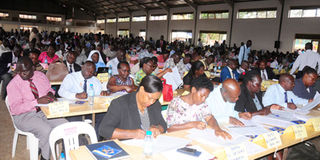Can selection exercise be made fairer to rural students?

S5 selections. School heads and representatives during the Uganda Certificate Education selection 2018 at the UMA show grounds last week. PHOTO BY RACHEL MABALA
What you need to know:
- Hike in points. In light of the recent hike in selection cut off points, would a student from Buliisa or Bukwo, one of the worst performing districts, have a chance of joining St Marys’ College Kisubi or Gayaza High School for A-Level?
- Rethink. What the country needs is a rethink of the governance and the sharing of resources within the region. Political and economic power shouldn’t be centred in Kampala and Entebbe alone.”
Prof Paul Wangoola,
On Wednesday, the curtain came down on the Senior Five students selection exercise at the Uganda Manufacturers’ Association (UMA) show grounds in Lugogo.
The process that kicked off on Tuesday saw some of the country’s top performing schools hike their entry points.
For example, Kings’ College Budo set the mark at aggregate 10 for boys and aggregate 12 for girls, St Marys’ College Kisubi set the mark at aggregate 12, all girls’ schools, Gayaza High School, Wanyange Girls’ School and Mariam High School set their marks at 14, 18 and 28 respectively.
The increment was believed to have been occasioned by an improvement in performance in the Uganda Certificate of Education (UCE) examinations.
Results released by the Uganda National Examinations Board (Uneb) had pointed to all round improvement in national examinations. The number of those who passed in Division One increased to 326,212 in 2017, up from 323,276 in 2016 and the failure rate dropped from 13.1 per cent in 2016 to 8.9 in 2017.
The biggest number of failures were, however, registered in rural Universal Secondary Education (USE) schools in 12 districts including Bukwo, Bundibugyo and Buliisa where failure rates ranged between 18 and 28.7 per cent, way above the national average of 8.8 per cent.
Bukwo as a district had only one student passing in Division One, Kween had four, Bulambuli six, Butaleja 12, Buliisa 16, Sironko 19 and Bududa 12 passing in Division one, but these were mostly categorized as “weak”.
In light of the recent hike in selection cut off points would a person from Buliisa or Bukwo have a chance of joining Kisubi or Gayaza?
“For now it looks almost impossible,” says the chairperson of the Parliamentary Committee on Education and Sports, Ms Nakayenze Connie Galiwango, who is also the MP (NRM) for Mbale District.
Ms Galiwango says whereas the introduction of Universal Primary Education (UPE) and USE led to a tremendous rise in enrolment figures with numbers in government aided primary and secondary schools, the numbers have since led to glaring disparities in the education sector.
Former Makerere University don, Prof Paul Wangoola, says whereas the colonial administrators had put in place a system that was driven by a desire to tap the best and most talented in the land, that system has since been replaced by another that puts at a disadvantage those who on account of an accident of birth or standing on the social economic rung find themselves in rural schools, a factor which is never considered at examination for during selection for Senior 5.
Ms Galiwango blames this seemingly discriminatory state of affairs on the Ministry of Education and Sports.
“We tasked the ministry of Education to address this disparity at the beginning of last year (2017), but it has never gotten back to us,” she says. The challenge though is how the Ministry of Education and Sports and the examinations’ governing body will proceed.
On October 12 last year, Uneb’s executive secretary, Mr Daniel Nokrach Odongo, announced that schools would with effect from this year be graded according to what they add to a student.
“The new measure will take into account the grades a child attained in P7 and those in S4 and the performance of all candidates. At the end of four years in secondary, if such a child who had a third or fourth grade at p7 gets a second grade, the school will have definitely added value to this student,” he said.
This year’s selection exercise did not take that into consideration. It remained urban centric. This is unfair to the rural schools and needs to be corrected, but how?
The Country Representative of Uwezo, Ms Goretti Nakabugo, calls for some form of affirmative action to give a chance to the rural students to compete with his urban counterparts.
“Right from the start the ground is not level. We need some form of affirmative action,” she argues.
In 1990 government introduced the 1.5 points affirmative action scheme to help boost the number of female students enrolling in the only public university then. The number of female students at Makerere has since shot up from 20 per cent in 1990 to about 46 per cent.
If it came in force would it help trigger a rise in the number of rural based students accessing education in the much hyped urban based secondary schools?
However, Prof Paul Wangoola, differs. He insists that affirmative action is not an option.
“What the country needs is a rethink of the governance and the sharing of resources within the region.
Political and economic power shouldn’t be centred in Kampala and Entebbe alone as the case is today because that way the political and economic power works and caters for only about 10 per cent of the population,” he argues.
Whatever the arguments, the country is in dire need of action to correct the injustice that the rural folk are being subjected to. They do not deserve it. The country does not deserve it.




